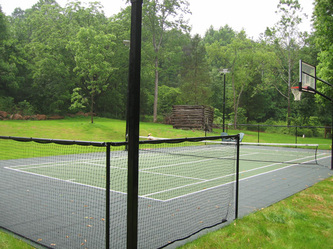GameCourt Components
Ball Containment: Ball containment is like fencing except the material is typically netting and not chainlink fence. The intent is to stop runaway balls, not keep people off the court. It's also better at blending in to the scenery and being unobtrusive. Ball containment can be placed within the edges of the court, or off the court. Placing it off the court increases the playing area but can create a landscape or maintenance issue. What to put between the court and the ball containment is the question, and depending on the amount of space, shrubs or ground cover work well. Grass is also an option but requires mowing. Ball containment is typically available in 10' high or 5' high. It can also be hung like a shower curtain, from a steel cable (like a zip-line).
Lighting: Lighting is an interesting feature in court construction. Frequently, it's the most controversial aspect of a neighbor's court. Nobody wants light from a court nearby coming into their yard or house, and the prospect of basketball games and noise lasting well into the night causes fear for homeowner's associations. There are two types sports lights, box-lights that cast light down onto the court, and directional sports lights with individual heads that can be pointed at specific parts of the court. Most lights are 240v although there are also 120v lights available and also LED lights. When comparing lighting, pay attention to lumens instead of voltage, since how much energy a light draws isn't indicative of the amount of light it casts.
Rebounder: A rebounder is a silent backboard made of a taunt net stretched between a metal frame and secured with bungee cords. The rebounder allows tennis, lacrosse, and soccer players to practice by themselves, with little noise and rapid ball response. Most rebounders can be incorporated right into a ball containment system and are available in 10'x10', 10'x15', and 10'x20'. We've also seen custom rebounders that run the entire width of a court.
Net Adjustment System: On multi sport game courts, a center net is stretched between two poles at mid-court. The two poles can be the basketball hoop and a light post, two net posts, two lights, etc., and usually one post will hold the winch and net adjustment hardware while the other pole is just for attaching the net. Above is a photograph of a net adjustment system winch and beside it is a stainless steel boathook, used to attach the net to the other side of the court.
Additional Game Markings: Frequently customers start out wanting lines for multiple sports and their initial design incorporates basketball, pickle ball, volleyball, and more. While anything is possible, too many lines can be confusing and our advice is usually to narrow it down to two sports and use the same markings for several games. Particularly if the dimensions aren't going to be official, close is good enough for fun.
Lighting: Lighting is an interesting feature in court construction. Frequently, it's the most controversial aspect of a neighbor's court. Nobody wants light from a court nearby coming into their yard or house, and the prospect of basketball games and noise lasting well into the night causes fear for homeowner's associations. There are two types sports lights, box-lights that cast light down onto the court, and directional sports lights with individual heads that can be pointed at specific parts of the court. Most lights are 240v although there are also 120v lights available and also LED lights. When comparing lighting, pay attention to lumens instead of voltage, since how much energy a light draws isn't indicative of the amount of light it casts.
Rebounder: A rebounder is a silent backboard made of a taunt net stretched between a metal frame and secured with bungee cords. The rebounder allows tennis, lacrosse, and soccer players to practice by themselves, with little noise and rapid ball response. Most rebounders can be incorporated right into a ball containment system and are available in 10'x10', 10'x15', and 10'x20'. We've also seen custom rebounders that run the entire width of a court.
Net Adjustment System: On multi sport game courts, a center net is stretched between two poles at mid-court. The two poles can be the basketball hoop and a light post, two net posts, two lights, etc., and usually one post will hold the winch and net adjustment hardware while the other pole is just for attaching the net. Above is a photograph of a net adjustment system winch and beside it is a stainless steel boathook, used to attach the net to the other side of the court.
Additional Game Markings: Frequently customers start out wanting lines for multiple sports and their initial design incorporates basketball, pickle ball, volleyball, and more. While anything is possible, too many lines can be confusing and our advice is usually to narrow it down to two sports and use the same markings for several games. Particularly if the dimensions aren't going to be official, close is good enough for fun.





